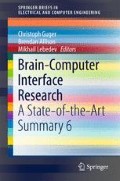Abstract
A rat robot is a type of animal robot in which an animal is connected to a machine system via a brain-computer interface (BCI). Electrical stimuli can be generated by the machine system and delivered to the animal’s brain to control its behavior. However, most existing rat robots require that a human observes the environmental layout to guide navigation, which limits the applications of rat robots. This work incorporates object detection algorithms to a rat robot system to enable it to find ‘human-interesting’ objects, and then use these cues to guide its behaviors to perform automatic navigation. A miniature camera is mounted on the rat’s back to capture the scene in front of the rat. The video is transferred via a wireless module to a computer and we develop some object detection/identification algorithms to allow objects of interest to be found. Next, we make the rat robot perform a specific motion automatically in response to a detected object, such as turning left. A single stimulus does not allow the rat to perform a motion successfully. Inspired by the fact that humans usually give a series of stimuli to a rat robot, we develop a closed-loop model that issues a stimulus sequence automatically according to the state of the rat and the objects in front of it until the rat completes the motion successfully. Thus, the rat robot, which we refer to as a rat cyborg, is able to move according to the detected objects without requiring manual operations. The closed-loop stimulation model is evaluated in experiments, which demonstrate that our rat cyborg can accomplish human-specified navigation automatically.
This is a brief version of the published article in IEEE Computational Intelligence Magazine, 2015 [14].
Access this chapter
Tax calculation will be finalised at checkout
Purchases are for personal use only
References
Bin G, Gao X, Wang Y, Hong B, Gao S (2009) VEP-based brain-computer interfaces: time, frequency, and code modulations [research frontier]. IEEE Comput Intell Mag 4(4):22–26
Wolpaw J, Wolpaw EW (2012) Brain-computer interfaces: principles and practice. Oxford University Press
Holzer R, Shimoyama I (1997) Locomotion control of a bio-robotic system via electric stimulation. IEEE/RSJ Int Conf Intell Robots Syst 3:1514–1519
Paxinos G (2004) The rat nervous system. Academic Press
Feng Z, Chen W, Ye X, Zhang S, Zheng X, Wang P, Jiang J, Jin L, Xu Z, Liu C, Liu F, Luo J, Zhuang Y, Zheng X (2007) A remote control training system for rat navigation in complicated environment. J Zhejiang Univ Sci A 8(2):323–330
Talwar S, Xu S, Hawley E, Weiss S, Moxon K, Chapin J (2002) Behavioural neuroscience: rat navigation guided by remote control. Nature 417(6884):37–38
Li Z, Hayashibe M, Fattal C, Guiraud D (2014) Muscle fatigue tracking with evoked EMG via recurrent neural network: Toward personalized neuroprosthetics. IEEE Comput Intell Mag 9(2):38–46
Wu Z, Pan G (2013) Smartshadow: models and methods for pervasive computing. Springer
Wu Z, Pan G, Zheng N (2013) Cyborg intelligence. IEEE Intell Syst 28(5):31–33
Wu Z, Pan G, Principe JC, Cichocki A (2014) Cyborg intelligence: Towards bio-machine intelligent systems. IEEE Intell Syst 29(6):2–4
Wu Z, Yang Y, Xia B, Zhang Z, Pan G (2014) Speech interaction with a rat. Chin Sci Bull 59(28):3579–3584
Wu Z, Zhou Y, Shi Z, Zhang C, Li G, Zheng X, Zheng N, Pan G (2016) Cyborg intelligence: recent progresses and future directions. IEEE Intell Syst 31(6):44–50
Yu Y, Pan G, Gong Y, Xu K, Zheng N, Hua W, Zheng X, Wu Z (2016) Intelligence-augmented rat cyborgs in maze solving. PLoS ONE 11(2):e0147754
Wang Y, Lu M, Wu Z, Tian L, Xu K, Zheng X, Pan G (2015) Visual cue-guided rat cyborg for automatic navigation. IEEE Comput Intell Mag 10(2):42–52
Hermer-Vazquez L, Hermer-Vazquez R, Rybinnik I, Greebel G, Keller R, Xu S, Chapin J (2005) Rapid learning and flexible memory in “habit” tasks in rats trained with brain stimulation reward. Physiol Behav 84(5):753–759
Reynolds J, Hyland B, Wickens J (2001) A cellular mechanism of reward-related learning. Nature 413(6851):67–70
Romo R, Hernández A, Zainos A, Brody C, Lemus L (2000) Sensing without touching: psychophysical performance based on cortical microstimulation. Neuron 26(1):273–278
Schultz W (2002) Getting formal with dopamine and reward. Neuron 36(2):241–263
Wang Y, Su X, Huai R, Wang M (2006) A telemetry navigation system for animal-robots. Robot 28(2):183–186
Bourdev L, Brandt J (2005) Robust object detection via soft cascade. IEEE Comput Soc Conf Comput Vis Pattern Recognit 2:236–243
Harris C, Stephens M (1988) A combined corner and edge detector. In: Alvey vision conference, vol. 15. p 50
Lucas BD, Kanade T (1981) An iterative image registration technique with an application to stereo vision. IJCAI 81:674–679
Acknowledgements
This work was supported by the grants from the National 973 Program (no. 2013CB329500), National Natural Science Foundation of China (No. 61673340) and Zhejiang Provincial Natural Science Foundation of China (LZ17F030001, LR15F020001)
Author information
Authors and Affiliations
Corresponding author
Editor information
Editors and Affiliations
Rights and permissions
Copyright information
© 2017 The Author(s)
About this chapter
Cite this chapter
Wang, Y., Lu, M., Wu, Z., Zheng, X., Pan, G. (2017). Visual Cue-Guided Rat Cyborg. In: Guger, C., Allison, B., Lebedev, M. (eds) Brain-Computer Interface Research. SpringerBriefs in Electrical and Computer Engineering. Springer, Cham. https://doi.org/10.1007/978-3-319-64373-1_7
Download citation
DOI: https://doi.org/10.1007/978-3-319-64373-1_7
Published:
Publisher Name: Springer, Cham
Print ISBN: 978-3-319-64372-4
Online ISBN: 978-3-319-64373-1
eBook Packages: Computer ScienceComputer Science (R0)

